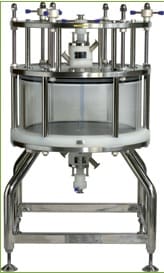Resin Life Cycle Validation – An Important Factor in Any Validation Program
The purpose of performing resin life cycle validation is to demonstrate that the column resins for the process are capable of maintaining acceptable performance throughout the lifetime of the resin. It is also to demonstrate that the resin can be successfully cleaned and reused. The target number of resin cycles should be established through small scale studies. Since certain resins can be expensive and repacking of columns can add extra time to a possibly already tight manufacturing schedule, it’s important to demonstrate resins can effectively be reused in the manufacturing process.

The resin reuse, large scale, study should demonstrate that the operational parameters of the column and skid perform as expected (including different flow rates and pressures) while at the same time verifying certain conditions of the buffers and product load are within the defined specifications. Impurity removal should also be considered when developing the study as different resins within the process are used for removal of certain impurities. This information can be gathered from small scale studies. Log reduction calculations should be used to show the ability of the resins to successfully remove the impurities through the entire process. The elution profile should also be compared throughout the lifetime of the resin. This can be done by overlaying the elution peaks from the chromatograms on top of each other and evaluating the peak for any splits or broadening.
In order to demonstrate the clean-ability of the resins, mock or blank runs should be performed. A mock run is typically identical to the production process with the exception of product being loaded onto the column. A mock elution is collected and certain samples (typically bioburden, endotoxin and protein) are collected to show that the cleaning process is successful in removing any microbial contaminants and that there is no/minimal product carryover from lot to lot. A risk assessment may be used to determine the number of mock runs performed during the process, but a good starting point would be the first three uses of the resin and the final use. Certain regulatory agencies require data for the first three (3) consecutive cleaning cycles. A mock run after the final use will show that cleaning was acceptable for the lifetime of the resin.
Resin lifetime studies can present their own unique challenges. Some of these challenges include scheduling mock runs within the production schedule, working with various labs for specific testing as well as the potential duration of the study as, depending on the manufacturing schedule, these studies could take months or years to complete.
Article by: Robert Farley, Managing Consultant, ICQ Consultants Corp.

